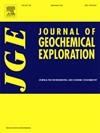利用磷灰石微量元素评价斑岩铜的肥力:一种机器学习方法
IF 3.4
2区 地球科学
Q1 GEOCHEMISTRY & GEOPHYSICS
引用次数: 0
摘要
由于磷灰石中的微量元素对岩浆的组成、氧化状态和结晶过程具有重要的线索,因此磷灰石化学成分常被用来评价岩浆的铜(Cu)富集度。然而,基于磷灰石微量元素的低维铜育性判别在实践中存在很大的局限性和不确定性。本文利用高维磷灰石成分数据集(跨越20种微量元素)训练随机森林和支持向量机等机器学习模型,用于区分含矿岩浆和无矿岩浆。结果表明,与传统判别图(56%)相比,ML模型对含矿样品中给定磷灰石的识别精度(96%)更高。特征重要性分析表明,δEu和Sr是高维ML模型区分含矿和无矿样品的最重要指标。含矿侵入体磷灰石的δEu和Sr浓度较高,Pb浓度较低,Sr/Y比值高于无矿侵入体。δEu和Sr浓度的升高表明母岩浆的氧化态和含水量相对较高,可能促进了硫酸盐的形成和Cu的释放和运输。此外,含矿磷灰石Sr/Y比值较高,表明产矿岩浆成分类似埃钠岩,而Pb浓度较低,表明岩浆演化过程中流体参与较强。将训练后的ML模型应用于菲律宾Tampakan地区的磷灰石,为矿石侵入前、同步和后的Cu繁殖提供了新的见解。该模型的普遍适用性表明,在矿物微量元素数据基础上建立的基于ml的判别方法为斑岩铜富性评价提供了新的有力工具。本文章由计算机程序翻译,如有差异,请以英文原文为准。
Appraising the porphyry Cu fertility using apatite trace elements: A machine learning method
Apatite chemical composition has often been invoked for appraising the magmatic copper (Cu) fertility, because trace elements in apatite hold important clues for tracing magma composition, oxidation states, and crystallization processes. However, low-dimensional Cu fertility discriminants developed on apatite trace elements suffer from significant limitations and uncertainties in practice. Here, machine learning (ML) models including random forests and support vector machines were trained using high-dimensional apatite composition dataset (spanning 20 trace elements) for discriminating ore-bearing magmas from ore-barren magmas. The results suggest that the ML models obtained a higher accuracy (96 %) for identifying the given apatites from ore-bearing samples compared to that of traditional discriminant diagrams (56 %). The feature importance analysis suggests that δEu and Sr are the most significant proxy for distinguishing ore-bearing and ore-barren samples when using high-dimensional ML models. In general, apatites from ore-bearing intrusion have higher δEu and Sr concentration, lower Pb concentration, and elevated Sr/Y ratio than ore-barren samples. Specifically, the elevated δEu and Sr concentration indicate a relatively higher oxidation state and water content in parental magmas, which could have promoted sulfate formation and Cu release and transport. Moreover, the elevated Sr/Y observed in apatite from ore-bearing samples imply the adakite-like composition of the ore-productive magmas, while lower Pb concentration suggests strong fluid participation during magmas evolution. The trained ML model was applied to apatites from the Tampakan district of the Philippines, providing new insights on Cu fertility of pre-, syn- and post-ore intrusions. The general applicability of this model demonstrates that ML-based discriminants developed on mineral trace element data provide new powerful tools for appraising the porphyry Cu fertility.
求助全文
通过发布文献求助,成功后即可免费获取论文全文。
去求助
来源期刊

Journal of Geochemical Exploration
地学-地球化学与地球物理
CiteScore
7.40
自引率
7.70%
发文量
148
审稿时长
8.1 months
期刊介绍:
Journal of Geochemical Exploration is mostly dedicated to publication of original studies in exploration and environmental geochemistry and related topics.
Contributions considered of prevalent interest for the journal include researches based on the application of innovative methods to:
define the genesis and the evolution of mineral deposits including transfer of elements in large-scale mineralized areas.
analyze complex systems at the boundaries between bio-geochemistry, metal transport and mineral accumulation.
evaluate effects of historical mining activities on the surface environment.
trace pollutant sources and define their fate and transport models in the near-surface and surface environments involving solid, fluid and aerial matrices.
assess and quantify natural and technogenic radioactivity in the environment.
determine geochemical anomalies and set baseline reference values using compositional data analysis, multivariate statistics and geo-spatial analysis.
assess the impacts of anthropogenic contamination on ecosystems and human health at local and regional scale to prioritize and classify risks through deterministic and stochastic approaches.
Papers dedicated to the presentation of newly developed methods in analytical geochemistry to be applied in the field or in laboratory are also within the topics of interest for the journal.
 求助内容:
求助内容: 应助结果提醒方式:
应助结果提醒方式:


